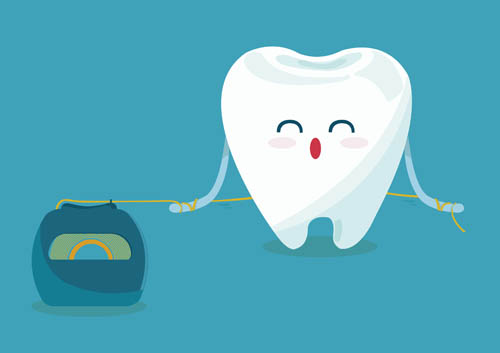October 17th, 2017

Do you have a space where a tooth used to be? Were you born with a missing tooth? Are you getting ready for dentures? You may be a good candidate for a dental implant. Metal dental implants were invented in 1965. Technology continues to advance with millions of implants placed in the United States and Canada. Placing implants has become mainstream and a common practice for offices like ours.
A dental implant is a small titanium post, which resembles a screw with threads. The post also has holes for bone to integrate. A dental implant is placed into the jawbone during a short dental procedure. It is relatively painless with very little post-operative pain. The threads on the implant post allow for the bone to fill in and integrate. To facilitate this process the implant is re-covered with gum tissue and allowed to heal and integrate for nearly three months. The implant acts as the root for the tooth to provide solid and stable support for the crown that’s yet to be placed.
The next step in the dental procedure is to uncover the implant and place a healing cap to allow the gum tissue to heal. After a short period of healing, an impression is taken to fabricate a crown to fully restore the missing tooth. The crown is then cemented on top of the post, at which point you can resume normal eating activities.
Dental implants do require some special care, but that is easily managed when you follow the directions outlined by Dr. Kirk Fishbaugh. During your regularly scheduled cleaning, special instruments are used to clean implants. While a dental implant cannot get a cavity, a condition known as peri-implantitis can occur. This is very similar to periodontal disease as the end result is dental implant loss and loss of bone structure. Be sure to floss the dental implant daily and run the floss under the implant crown as far as it can go to remove food and plaque. If you use any picks or small brushes to go in between your teeth, make sure they are plastic. Metal will scratch the implant making it more susceptible to infection. Be sure to keep your regular dental visits and cleanings to monitor the implant and help preserve your investment.
October 10th, 2017

Of all the dental hygiene techniques you can use at home to promote clean teeth and good oral health, flossing is likely to be the one that troubles most people. It can be viewed as confusing and time-consuming, but when you learn how to floss your teeth correctly, you’ll find it’s easy to do on a daily basis.
Proper flossing techniques are vital to the health of your teeth and gums. These tips will help you with the correct flossing procedures. Likewise, Dr. Kirk Fishbaugh and our team can also help you learn how to floss effectively and efficiently.
Steps to Flossing Your Teeth Properly
- Choosing Dental Floss. You can find dental floss in various flavors, as well as waxed or unwaxed. If the floss you use seems to get stuck between your teeth, switch to waxed to make it easier.
- Flossing “Helpers.” Beginner flossers who have trouble coordinating the floss and the movements of their hands can use a floss holder to help them get in and around teeth.
- Preparing the Floss. Cut an 18-inch piece of floss to use for flossing a few teeth. This allows you to make progress before you must stop and cut another piece of floss.
- How to Hold It. Wind the ends around your middle fingers. Hold the floss taut, pinching each side with your thumbs and index fingers. Leave a couple inches free in the middle.
- The Process of Flossing. Use your index fingers to guide the floss toward your gum line. Bring it down between the teeth with a zigzag motion. Hold the floss in a C-shape around the tooth, and move it up and down along the side.
- Where to Floss. Use a clean portion of the floss to clean around and in between each tooth. Don’t forget about the molars in the back of your mouth, too!
Flossing: A Vital Part of Oral Care
Periodontal disease begins at the gum line; this is where flossing comes in. Regular flossing helps you remove plaque from the gum line and between your teeth to avoid gum disease. In conjunction with daily brushing and twice-a-year visits to Kirk Fishbaugh Dentistry, floss each day to maintain good oral hygiene and overall health. Gum disease can have an impact on your general health, but it doesn't have to. This easy-to-prevent condition can be avoided with regular visits to our Green Bay, WI office and daily flossing. Allow our team to partner with you in maintaining a bright, shiny smile and good oral health.
October 3rd, 2017

YES! Studies have shown a correlation between gum disease and heart disease, underscoring the importance of good oral health care. Cardiovascular disease remains American’s leading killer, claiming more lives than the rest of major causes of death, according to our friends at the American Heart Association. In fact, an estimated 80 percent of American adults currently have some form of gum disease, also known as periodontal disease.
Studies suggest that people with gum disease are believed to have an elevated risk of heart attack and stroke. Since most patients are not regularly visiting a heart specialist, their regular visits to our Green Bay, WI office can help detect early warning signs of heart issues, prevent gum disease, or at the very least catch it at its early stage. We’d also like you to know your numbers: blood pressure (less than 120/80), cholesterol (less than 200) and BMI (less than 25).
There are many benefits to visiting Kirk Fishbaugh Dentistry in addition to maintaining your dental health. If it has been a while since your last visit, please give us a call!
September 26th, 2017

The human heart truly appreciates it when we eat healthy foods, don’t smoke, and exercise regularly. But there’s something else that can improve your heart’s longevity and you may not know about: keeping your teeth and gums in tip-top shape.
Bacteria responsible for periodontal disease have been found in the heart area of subjects who suffer from artery inflammation, high cholesterol, and heart disease. Physicians and dentists, like Dr. Kirk Fishbaugh, think that it is not difficult for oral bacteria to enter the bloodstream through diseased, bleeding gums, and abscesses that reach from the gums into veins and capillaries that carry blood to and from the heart.
In addition to practicing good oral hygiene and visiting Kirk Fishbaugh Dentistry every six months, here are ten other ways you can make your heart love you for the rest of your life:
- Avoid eating foods that contain saturated fat (fatty meats, processed meats, pastries, butter).
- Craving a crunchy snack? Grab a handful of tree nuts: pecans, almonds, walnuts. They’re rich in monounsaturated fats (the “good” kind of fat) as well as vitamin E, magnesium, and potassium.
- Eating a bowl of oatmeal for breakfast nourishes your heart with a soluble fiber called beta-glucan that can reduce cholesterol and help prevent atherosclerosis.
- Think “fish” the next time you shop for groceries, especially sardines, salmon, fresh tuna, and mackerel. These fish provide omega-3 fatty acids that lower triglycerides and blood pressure, and may help prevent blood clots from forming.
- Opt for whole grains over processed white breads and cereals.
- Put that remote control (or computer mouse) down right now and get moving! Walk, swim, ride a bike, plant flowers; your heart likes to pump, so make it pump.
- Refresh your brain and improve your heart health with at least eight hours of sleep every night.
- De-stress your life as much as possible: relax, stay optimistic, and don’t sweat the petty stuff!
- Watch your weight and get regular health examinations, especially if you have a family history of heart disease.
- And don’t forget to brush, floss, and rinse twice a day!



